#École des Beaux-Arts
Photo



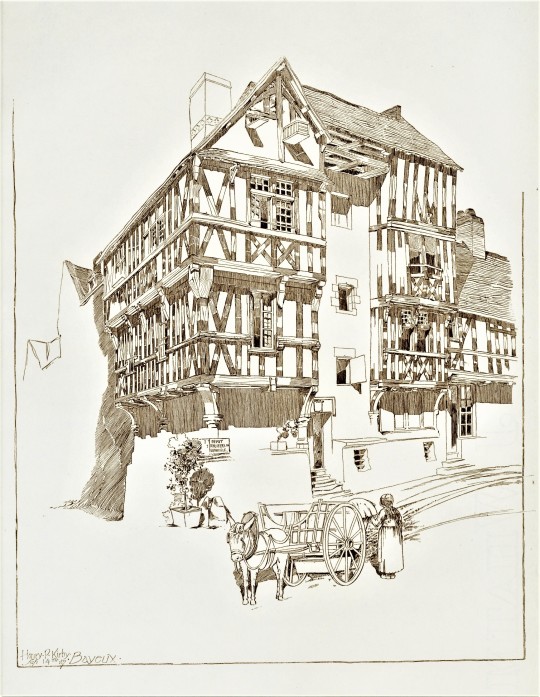
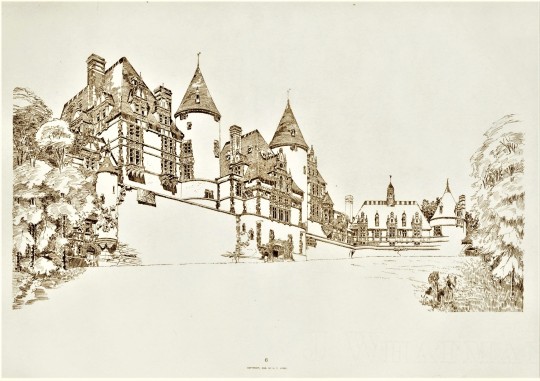
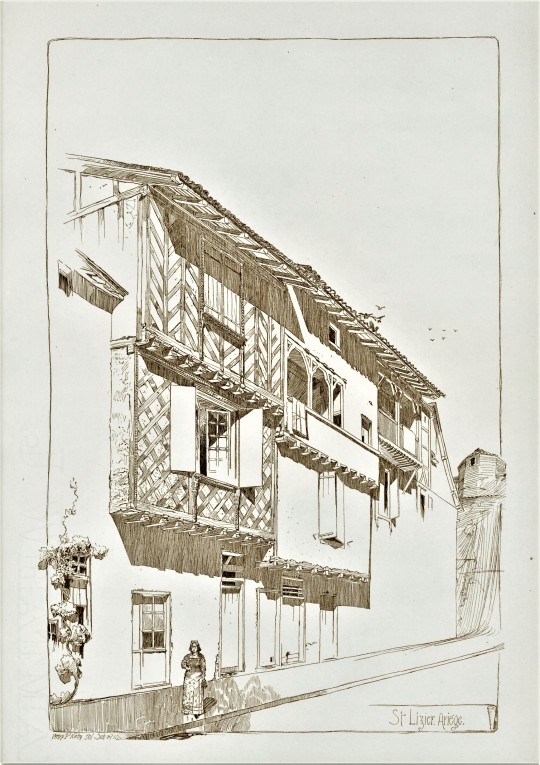

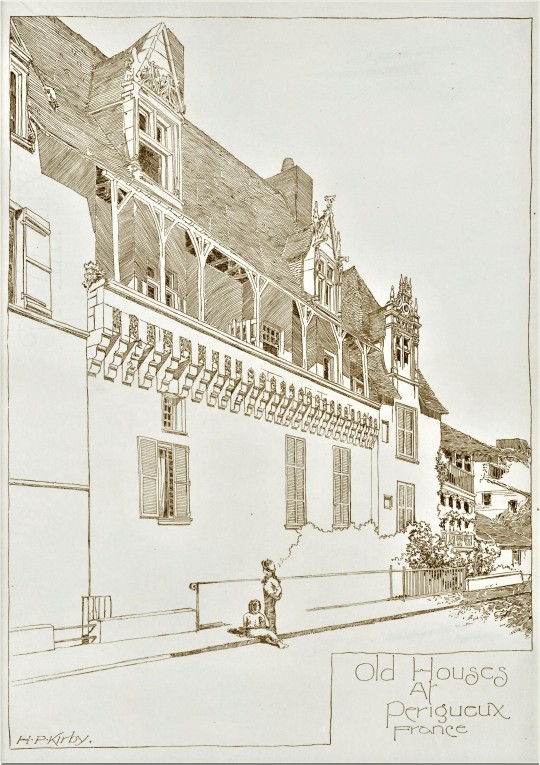
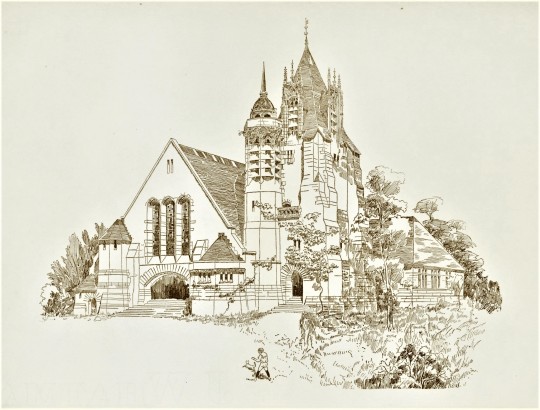
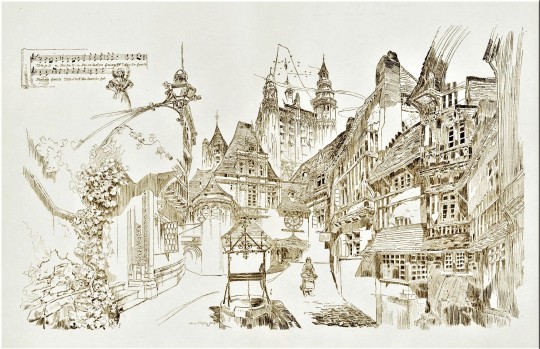
Decorative Sunday with Henry P. Kirby
These charming sketches are the work of New York architect Henry P. Kirby (1853 - 1915). Architectural Compositions contains fifty loose plates printed on Whatman paper and housed in a portfolio. It was published in Boston in 1892 by Bates, Kimball & Guild, publishers of one of the United State’s leading architectural journals of that time, The Architectural Review (Boston), not to be confused with the longer running Architectural Review still in publication out of London.
Kirby would have been working as a draftsman for George B. Post at the time of publication, for whom he later worked as lead designer before striking out on his own. Some of the subject matter also evokes Kirby’s time in France, where he studied at the École des Beaux-Arts after training with his father, also an architect. Per the subtitle, some of the sketches were “made in connection with actual projects,” while many were “the result of study during leisure moments.” I found Kirby’s eye for the human elements in his sketches particularly endearing, from the foreground figures to details on the buildings themselves, like open widows and overgrown foliage, or what looks like a duvet cover hanging out to dry (first image above).
For any music buffs reading, the final sketch includes some bars of "Très-jolie" from the opéra comique smash hit La Fille de Madame Angot.
Our copy of Architectural Compositions was gifted to UWM by Gustav A. Elgeti in 1966.
Find more Decorative Sunday posts here.
-Olivia, Special Collections Graduate Intern
#Decorative Sunday#Architectural Compositions#Henry P. Kirby#Henry Petit & Green#Bates Kimball & Guild#The Architectural Review#George B. Post#École des Beaux-Arts#La Fille de Madame Angot#decorative plates#decorative arts#beaux-arts#architecture#architectural drawings#architectural plates#olivia
422 notes
·
View notes
Text

1975 Paris, Ecole des Beaux-Arts, atelier Guignebert
#1975#Paris#école des Beaux-Arts#vintage#1970s#analog photography#film photography#photography#original photographers#streetphotography#blackandwhite#pierre wayser
37 notes
·
View notes
Text
academic art
Academic art, a style prevalent in the 19th century, adhered to traditional techniques and subject matter, often depicting historical, mythological, or biblical themes. It emphasized realism, precise draftsmanship, and idealized forms, aiming to elevate the viewer's moral and intellectual sensibilities. Led by institutions like the École des Beaux-Arts in Paris, academic art set strict standards, which some saw as stifling creativity. Yet, its influence persisted, shaping the development of art education and laying the groundwork for later movements to rebel against its conventions.

flaming june by frederic leighton
#art#artist#european style#academic art#daily art#french#frech aesthetic#french style#historical#greek mythology#traditional techniques#realism#école des beaux-arts#paris#art education#19th century#romantacism#neoclassicism#dark academism#light academism#academism#l'art pompier#eclecticism#historicism#syncretism#painting#sculpture#european academic#french académie#moral and intellectual sensibilities
3 notes
·
View notes
Text

source Moto Vitelloni - Wheels n' wings
68 notes
·
View notes
Text
¿La Web del Surrealismo? Clovis Trouille (1889-1975)

Clovis Trouille no era realmente un surrealista, sin embargo, en 1930 Dali y Aragon descubrieron la pintura contra la guerra de Clovis Trouille Remembrance en el Salón de pintores y escritores revolucionarios. André Breton lo consideró "el gran maestro de todo vale", y se ofreció a exhibir sus obras en su galería pero él se negó por temor a que lo etiquetaran de esa manera.
Nació en 1889 en La Fère, la región de Picardía de Francia y de 1905 a 1910 estudió en la École des Beaux-Arts de Amiens, y en 1907 su pintura La chica rubiaSe llevó el primer premio de Bellas Artes de Amiens. Además de pintura, Trouille estudió moda y publicidad, y trabajó como diseñador para chez Draeger. Sus experiencias en el frente en la Primera Guerra Mundial le dieron un odio de por vida hacia los militares y lo volvieron bastante anarquista
#Clovis Trouille Nació en 1889 en La Fère la región de Picardía de Francia y de 1905 a 1910 estudió en la École des Beaux-Arts de Amiens y en#¿Esta es la imagen y algunos datos (O no) la “Historia” la pones tú? ¡La tuya! ¿Lo harás...?#surrealismo
10 notes
·
View notes
Text
The grounds of École de magie et des beaux-arts, or School of magic and Arts (Lyon, France)
The grounds of École de magie et des beaux-arts is one of the most expansive in the world, with 200 acres of sprawling buildings and glass tunnels interconnecting them.
The school is organized almost in the same fashion as the city of Paris. Buildings and dorms are put in a snail-like curl, then separated into districts. The very center holds the dorms, library, sports center, and cafeteria.
District one, or the Arts District, is the outermost part of the curl and has a total of 2 buildings, both of which are brightly colored. The glass on the windows is handmade and shaped by previous students, as are the carpets.
The outermost building is used to teach students who are interesting in getting a degree in carpentry, while the second building is used for students going down the more conventional arts path, like pottery or painting.
District two, or the Cooking district, also has a total of 2 buildings, with the second being much more smaller and amounting to more of a cooking shed then anything else.
Here, the buildings are built in a way that the smoke from the many kitchens in the first building can all condense into a single chimney, which is then passed through a ward so that the smoke is nullified.
The second building is used to do one-on-one sessions with students who are in need of help, creating a sense of privacy many of them need.
District three, or the Music district, has a total of three buildings: the Main Hall, the Music Hall, and the Great Hall.
The Main Hall is dedicated to regular band classes. The one story building is totally soundproof and hosts a large selection of music pieces students can take and learn at their own will.
The Music Hall is dedicated to performances. The building looks somewhat similar to The Arsenal, Metz; large, white and gold walls, with big windows and quartz stairs. The air of professionalism helps students fall into character, getting a feel of what it feels like to be a professional musician.
The Great Hall is used for other classes, like DADA and Math and Science. It is also the only Music building with two floors; the second floor is filled with private, soundproof rooms so students can practice without being bothered.
The final district, the Dance District, has two buildings. The first building is entirely made out of dance studios catering to the student’s preferred style, with at least four floors and a large balcony on the third. The second building, like with the music district, is used for regular classes like gym and charms.
----
The snail-like grounds are surrounded by miles of trees and forests, as well as several wards and deflecting spells.
While the school puts incredible pressure on students, many are surprised by the revelation that teachers don’t dish out homework; assignments are done in class.
#École de magie et des beaux-arts#wizarding world#wizarding schools#HP#hp headcanon#Harry Potter#french schools
16 notes
·
View notes
Text
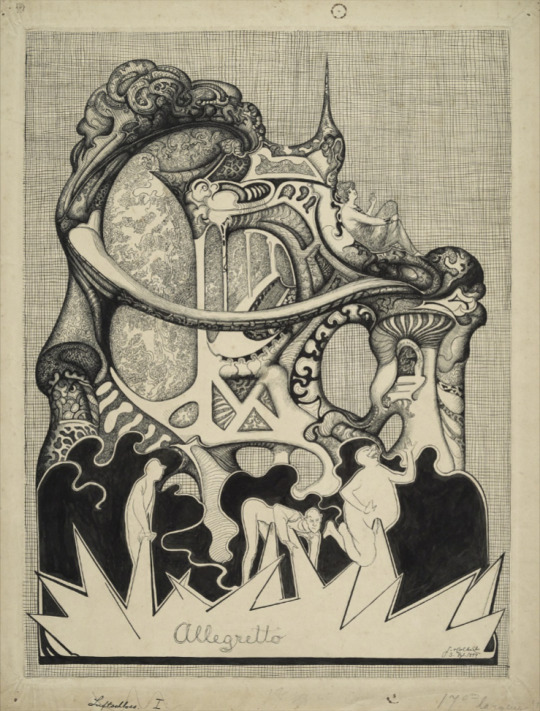
Johannes Holbek (Nov. 13, 1872 - 1903) was a Danish painter, illustrator and writer who studied very briefly at the Royal Academy before going of in search of Van Gogh and Gauguin’s mad visions. He studied in Paris at the École des Beaux-Arts with Gustave Moreau and others,
After his return to Denmark he began working for a newspaper, creating satirical drawings, and he also illustrated books, such as the poems of Alfred, Lord Tennyson. He was also working on a hybrid religious and philosophical work in drawings and text, but never finished it.
His Symbolist visions became more and more outré and he seemed headed for a psychotic breakdown, which came in 1903 and led to his hospitalization and death (possibly be his own hand).
Above - Johannes Holbek: Allegretto (Luftschloss I), 1899 - ink drawing (Museum Jorn)
#art#danish artist#johannes holbek#1890s#symbolist art#satirical drawings#book illustration#vincent van gogh#paul gauguin#gustave moreau#alfred lord tennyson#religious madness#école des beaux arts#danish royal academy of fine arts#frederik vermehren#museum jorn#allegretto#luftschloss#psychosis
10 notes
·
View notes
Text
Illustrations et dessins satiriques #74
La vie d’étudiant dans un atelier parisien, illustration de Samuel Begg pour The Illustrated London News, 23 décembre 1886.
LÉGENDE (de g. à d.) :
- duel du bleu de Prusse contre la lacque bordeaux (NDLR : allusion à la guerre perdue contre la Prusse) ;
- Français et Anglais : God Save The Queen contre la Marseillaise ;
- types d’étudiants ;
- pour ses péchés;
- un mauvais quart d’heure ;
- types de modèles ;
- dans les nues ! ;
- visite du professeur : tout n’est que silence (NDLR : on l’on voit un modèle nu bien jeune).
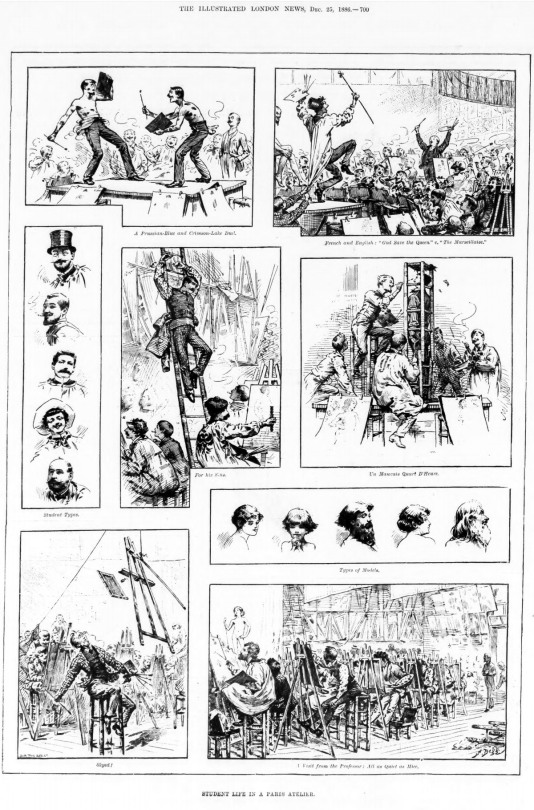
#modèle vivant#life models#beaux-arts#histoire des modèles vivants#histoire de l’art#modèle d’arts plastiques#écoles d’art#art students#humour#dessin satirique#vintage illustrations#art schools#Paris#bohème
0 notes
Text

Pierre Brissaud (1885 –1964) French
1924
French Art Deco illustrator, painter, and engraver whose father was Docteur Edouard Brissaud, a student of Docteur Charcot. He was born in Paris and trained at the École des Beaux-Arts and Atelier Fernand Cormon in Montmartre, Paris
798 notes
·
View notes
Text

François Salle - The Anatomy Class at the École des Beaux-Arts (1888)
163 notes
·
View notes
Text


One wrestler/model x two French artists (Bouguereau and Baudry) = two masterful paintings.
“Half Length Figure” c.1850 by William-Adolphe Bouguereau. (1825-1905). French painter. École national supérieure des Beaux-Arts. oil on canvas (left)
“The Wrestler Meissonier”, c.1848 by Paul-Jacques-Aimé Baudry (1828-1886). French Academic classical painter. Calvet Museum, Avignon, FR. oil on canvas (right)
245 notes
·
View notes
Text

1975 Paris, ecole des Beaux-Arts
#1975#Paris#école des beaux-arts#vintage 1970s#analog photography#film photography#photography#original photographers#streetphotography#blackandwhite#pierre wayser
14 notes
·
View notes
Text



ANDREW GARFIELD & FLORENCE PUGH ♡
— Valentino Ready To Wear Spring 2024 held at École des Beaux Arts on October 1, 2023 in Paris, France.
#andrew garfield#florence pugh#paris fashion week#pfw 2023#valentino#andrewgarfieldedit#florencepughedit#actors#FAVVVVVVS <333#useranna3
233 notes
·
View notes
Text

Alexander McQueen for Givenchy Spring/Summer 1997 show, École des Beaux-Arts, Paris
381 notes
·
View notes
Text
¿La Web del Surrealismo? Clovis Trouille (1889-1975)

Clovis Trouille no era realmente un surrealista, sin embargo, en 1930 Dali y Aragon descubrieron la pintura contra la guerra de Clovis Trouille Remembrance en el Salón de pintores y escritores revolucionarios. André Breton lo consideró "el gran maestro de todo vale", y se ofreció a exhibir sus obras en su galería pero él se negó por temor a que lo etiquetaran de esa manera.
Nació en 1889 en La Fère, la región de Picardía de Francia y de 1905 a 1910 estudió en la École des Beaux-Arts de Amiens, y en 1907 su pintura La chica rubiaSe llevó el primer premio de Bellas Artes de Amiens. Además de pintura, Trouille estudió moda y publicidad, y trabajó como diseñador para chez Draeger. Sus experiencias en el frente en la Primera Guerra Mundial le dieron un odio de por vida hacia los militares y lo volvieron bastante anarquista
#Clovis Trouille Nació en 1889 en La Fère la región de Picardía de Francia y de 1905 a 1910 estudió en la École des Beaux-Arts de Amiens y en#¿Esta es la imagen y algunos datos (O no) la “Historia” la pones tú? ¡La tuya! ¿Lo harás...?#Surrealista
4 notes
·
View notes
Text

The Embrace (1937) by Léonard Sarluis (1874-1949), Netherlands born French painter.
Born in the Hague in October of 1874, French painter Salomon-Léon Sarluis, known as Léonard Sarluis, studied at the École des Beaux-Arts before moving to Paris in 1884 where he became a well known figure on its boulevards. He was a student of the French Symbolist painter Armand Point and of the French novelist Élémir Bourges, who was strongly linked with the Decadent and Symbolist movements in literature. Sarluis was also associated with the openly gay poet Jean Lorrain, who is remembered for his contributions to the satirical weekly Le Courrier Français and his Decadent novels and short stories.
Léonard Sarluis traveled widely throughout Italy, visiting Naples, and Russia. Upon his return to Paris, he exhibited at the Salon de la Rose Croix and the Salon des Artistes Français, and at a number of other Parisian galleries. With designer Armand Point, Sarluis created the poster for the fifth exhibition at the Salon des Artistes Français, depicting Perseus holding the severed head of novelist Émile Zola, who was rejected by the Symbolists for his Naturalist social commentary.
Working under the influence of Point, Léonard Sarluis combined a technique inspired by the Old Masters with a style that was sensual and very modern. He liked to work on a grand scale, and his monumental “Nero”, exhibited at the Galerie Georges Petit in Paris, was greatly admired by muralist painter Puvis de Chavannes. In 1919 Sarluis had a solo exhibition at the Galerie Bernheim, one of the oldest galleries in Pairs and a leader in avant-garde art.
In 1923, Sarluis produced illustrations based on novelist Gaston Pavloski’s 1912 mystical “Voyage to the Land of the Fourth Dimension”. For a number of years, Sarluis worked on a series of three hundred-sixty paintings entitled “A Mystical Interpretation of the Bible”, which were shown at the Grafton Galleries in London in 1926.
Léonard Sarluis’s inspiration was emblematic of a turn of the century that combined nostalgia for an imagined past, decadent themes and sometimes cloudy mysticism. A provocative character and dandy, and a friend of Oscar Wilde, Salomon-Léon Sarluis died in 1949 in Paris.
55 notes
·
View notes